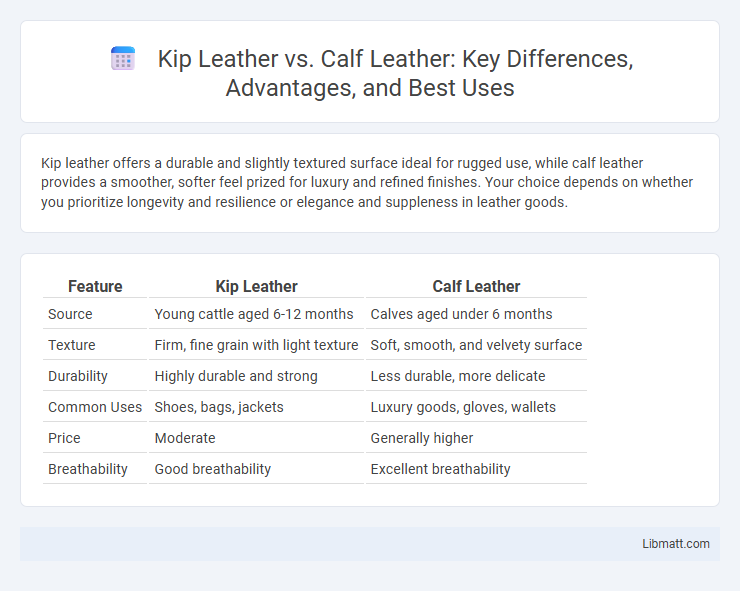Kip leather offers a durable and slightly textured surface ideal for rugged use, while calf leather provides a smoother, softer feel prized for luxury and refined finishes. Your choice depends on whether you prioritize longevity and resilience or elegance and suppleness in leather goods.
Table of Comparison
| Feature | Kip Leather | Calf Leather |
|---|---|---|
| Source | Young cattle aged 6-12 months | Calves aged under 6 months |
| Texture | Firm, fine grain with light texture | Soft, smooth, and velvety surface |
| Durability | Highly durable and strong | Less durable, more delicate |
| Common Uses | Shoes, bags, jackets | Luxury goods, gloves, wallets |
| Price | Moderate | Generally higher |
| Breathability | Good breathability | Excellent breathability |
Introduction to Kip Leather and Calf Leather
Kip leather, derived from young cattle typically aged 6 to 12 months, offers a balanced blend of strength and softness, making it highly durable yet supple for luxury goods. Calf leather, sourced from even younger calves usually under six months old, is prized for its fine grain, smooth texture, and exceptional softness, making it ideal for high-end fashion and accessories. Your choice between kip and calf leather should consider the desired durability and texture, with kip providing more robustness and calf leather offering a delicate, refined finish.
Defining Kip Leather: Characteristics and Origins
Kip leather originates from young cattle aged between six to twelve months, offering a balance between the softness of calf leather and the durability of full-grown cowhide. Its fine grain and moderate thickness provide a resilient yet supple texture ideal for high-quality leather goods. If you're seeking a leather type that combines strength with a refined finish, Kip leather presents a unique option compared to calf leather.
What is Calf Leather? Key Features and Benefits
Calf leather is derived from young calves, making it exceptionally soft, smooth, and fine-grained compared to other types of leather. Its key features include superior durability, a luxurious texture, and an elegant appearance that improves with age, offering long-lasting quality. You can expect calf leather to provide a premium feel and resilience ideal for high-end shoes, bags, and accessories.
Durability Comparison: Kip Leather vs Calf Leather
Kip leather, derived from young cattle aged around 6 to 12 months, offers a balanced combination of softness and durability, making it more resistant to wear and scratch compared to calf leather, which comes from younger calves under 6 months and is softer but less durable. Calf leather is prized for its fine grain and smooth texture, suitable for luxury goods requiring delicate finishes, but it tends to wear out faster under heavy use. Kip leather's increased thickness and toughness make it ideal for products needing long-lasting resilience without compromising flexibility.
Texture and Appearance: Key Differences
Kip leather features a fine grain texture that is smoother and more durable compared to calf leather, which is softer with a more velvety and uniform surface. The appearance of kip leather tends to have a slight sheen with natural markings, offering a rugged yet refined look, while calf leather boasts a matte finish with minimal imperfections, giving it a classic and elegant feel. Your choice depends on whether you prefer the resilient texture of kip leather or the supple smoothness of calf leather for your leather goods.
Common Uses for Kip Leather and Calf Leather
Kip leather, known for its durability and medium thickness, is commonly used in high-quality shoe uppers, wallets, and bags that require a balance of strength and flexibility. Calf leather, prized for its smooth texture and fine grain, is frequently chosen for luxury goods such as premium dress shoes, handbags, and refined leather accessories. Both leathers serve distinct purposes in the fashion and accessories industry, with kip leather favored for robustness and calf leather for elegance.
Cost and Value Analysis
Kip leather commands a higher price compared to calf leather due to its superior durability and refined texture, making it a preferred choice for luxury leather goods. Calf leather offers excellent softness and a uniform grain but tends to wear faster, which impacts long-term value. Investing in kip leather often results in better longevity and sustained aesthetic appeal, providing greater value for premium leather products.
Maintenance and Care Requirements
Kip leather requires less frequent conditioning than calf leather due to its tighter grain and durability, making it more resistant to scratches and moisture. Calf leather demands careful maintenance, including regular moisturizing and protection from water to prevent drying and cracking. Your choice depends on how much time you can dedicate to leather care and the environment in which the leather goods will be used.
Environmental Impact and Ethical Considerations
Kip leather, sourced from young cattle aged 6-12 months, generally has a smaller environmental footprint than calf leather due to its use of animals already slaughtered for meat, reducing waste. Calf leather, derived from younger calves, often raises more ethical concerns related to animal welfare and the intensive farming practices required to produce high-quality hides. Both materials involve environmental impacts from tanning processes, but choosing kip leather can support more sustainable and ethical leather consumption by maximizing resource use.
Choosing Between Kip Leather and Calf Leather: Which is Better?
Kip leather, sourced from younger cattle aged 6 to 12 months, offers a balance of durability and softness, making it ideal for high-quality shoes and accessories that require longevity. Calf leather, derived from calves under six months old, is prized for its fine grain, smooth texture, and luxurious feel, perfect for elegant and delicate leather products. When choosing between kip leather and calf leather, consider your preference for durability versus suppleness, as your specific use and desired finish will determine which type suits your needs better.
Kip leather vs calf leather Infographic

 libmatt.com
libmatt.com